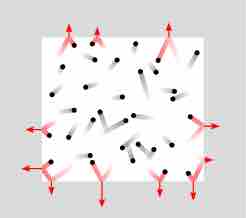Pressure (

Fluid Pressure and Force
Pressure as exerted by particle collisions inside a closed container.
Mathematically,
Pressure is a scalar quantity. It relates the vector surface element (a vector normal to the surface) with the normal force acting on it. The pressure is the scalar proportionality constant that relates the two normal vectors:
The subtraction (–) sign comes from the fact that the force is considered towards the surface element while the normal vector points outward. The total force normal to the contact surface would be:
Pressure is an important quantity in the studies of fluid (for example, in weather forecast). For fluids near the surface of the earth, the formula may be written as
This equation, for example, can be used to calculate the total force on a submarine submerged in the sea.